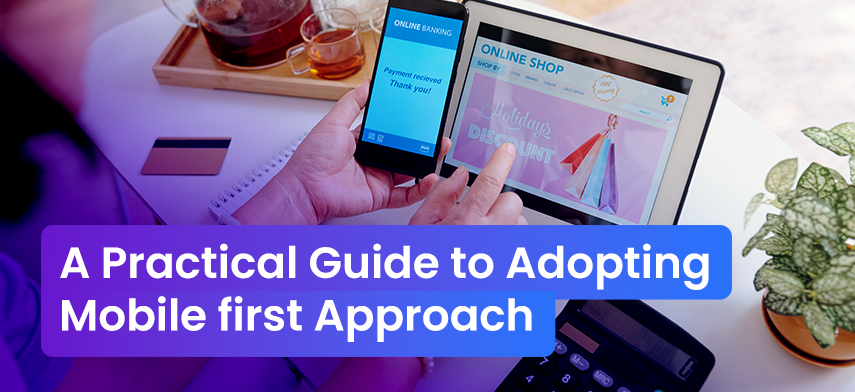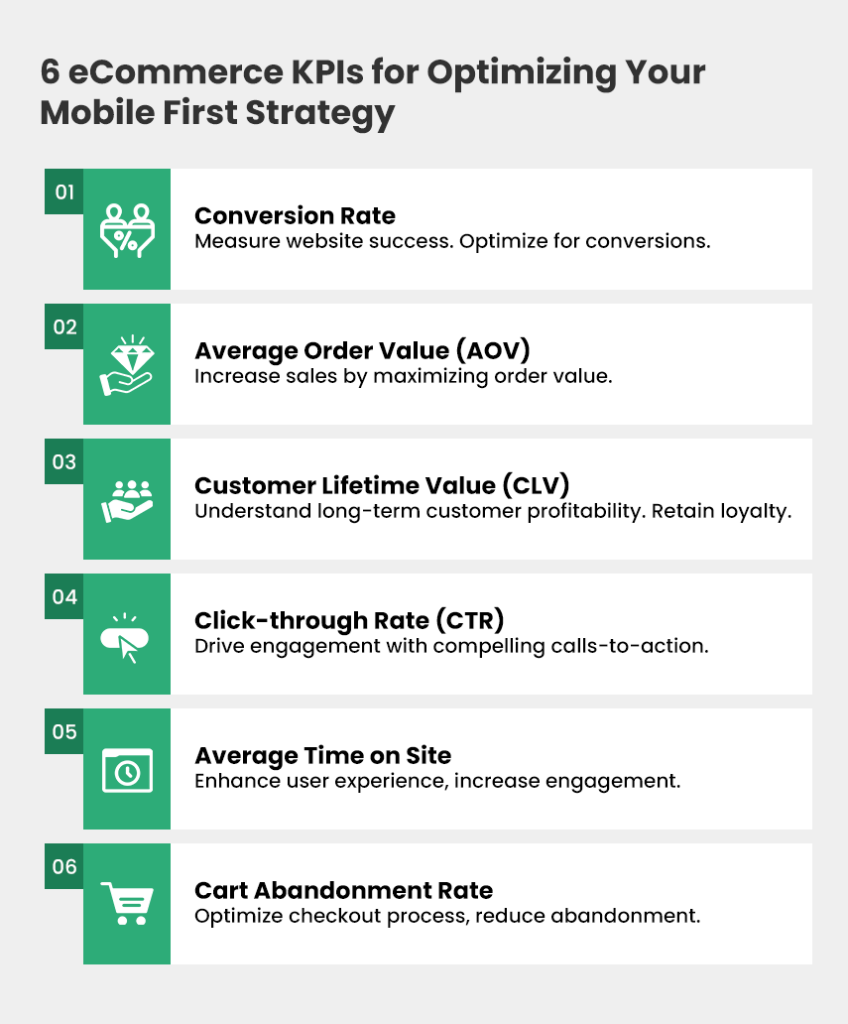Mobile devices have emerged as powerful catalysts for growth in the retail industry, reshaping the way consumers engage with brands and make purchase decisions. As a high-level decision-maker in a consumer retail brand, it is crucial to recognize the growing significance of mobile devices and stay current on business trends.

If your business has yet to tap into the power of mobile first approach, this blog is your guide to unlocking a world of opportunities. This blog is specifically crafted to address the needs of consumer retail brands not leveraging a ‘proven-to-succeed’ approach and shed light on its undeniable advantages and seamless implementation.
Our retail experts have diligently researched and analyzed the evolving landscape of the retail industry to provide you with reliable information. To guide your decision-making process, we will also emphasize the key metrics and KPIs that hold the utmost importance in the fast-paced digital world. So, let’s delve into the realm of the mobile first approach and explore its transformative potential.
Mobile First Approach – Foundation & Significance
The mobile first approach refers to a strategy that prioritizes designing and developing mobile-friendly experiences and adapting them to different screens. It is a strategic mindset and operational framework where brands prioritize mobile devices as the primary platform for delivering their products, services, and overall customer experience.
“Mobile first approach involves designing and optimizing every aspect of a brand’s digital presence with mobile devices as the primary focus.”
Implementing a mobile first approach involves designing websites and applications with responsive and mobile-friendly interfaces, ensuring fast loading speeds, optimizing for smaller screens, and leveraging mobile-specific features such as touch gestures and location-based services. This approach allows brands to:
- Capitalize on the increasing mobile usage trend and reach customers directly
- Deliver seamless, user-centric experiences that cater to the preferences and behaviors of mobile users
- Improve customer engagement and satisfaction
- Increase conversion rates, and ultimately drive revenue growth.
Insights into the Retail Landscape: A Quick Fact Check
In today’s digital age, more and more people access the internet on their mobile devices. 6.378 billion people own smartphones across the world. In the USA, approx 307 million people are expected to use mobile phones by 2028. And it’s predicted that 187.5 million of them will shop via mobile by 2024. A report found that the average consumer spends 3 hours and 15 minutes per day on their mobile device, with over 90% of that time spent on apps.
The above-shared statistics reveal the reality that mobile devices have become the primary touchpoint for consumers in their shopping journey and aim to provide a seamless, intuitive, and convenient experience that aligns with their preferences and behaviors.
The mobile first strategy also has benefits for search engine optimization (SEO) as Google uses mobile-first indexing to rank websites. By prioritizing mobile first design, designers can improve website loading times and optimize content for mobile users, leading to better SEO rankings and responsive web designs.
Google has recently revamped its search index to prioritize mobile optimization, given the rise of mobile shopping. This means that e-commerce stores that prioritize mobile-friendly design will enjoy higher organic search rankings compared to those that do not.
A mobile-first approach in the retail industry offers numerous benefits that can propel brands toward success in the digital landscape. Let’s explore the key advantages of embracing a mobile-first approach.
Benefits of Embracing A Mobile First Approach
As mobile devices increasingly dominate the digital landscape, businesses that prioritize mobile experiences position themselves for success in an era where customers are demanding seamless and convenient interactions. In this section, we delve into the compelling benefits of adopting a mobile-first approach.
Direct Reach to Customers
A mobile first approach can enable businesses to reach their customers directly through their mobile devices, offering personalized shopping experiences and promotions that are tailored to their preferences, actions, and interests.
Increased Revenue
300+ million consumers use their smartphones and tablets to make purchases. A mobile first approach can help businesses capture this growing market, enabling more business reach, driving more sales and revenue.
Lower Cost of Acquisition
Compared to traditional marketing channels, mobile marketing can be more cost-effective. This is because mobile marketing allows businesses to target specific audiences and measure the effectiveness of their campaigns, allowing them to optimize their spending for maximum ROI for the mobile first business.
Improved Customer Experience
A mobile first approach can provide customers with a seamless shopping experience that is optimized for their mobile devices. This can include easy navigation, fast page load times, and simple checkout processes, all of which can help to improve customer satisfaction and loyalty.
Data-Driven Decisions
Mobile apps provide valuable data and insights into customer behaviors, preferences, and purchasing patterns. Brands can analyze this data to gain a deeper understanding of their customers, refine their marketing strategies, and deliver personalized experiences that resonate with their target audience.
“Adopting a mobile-first approach sets the stage for business growth, innovation, and success in the ever-evolving digital landscape.” – Nitin Lahoti, Co-founder Mobisoft Infotech
Moving on, we need to understand what criteria consumers are expecting and what you as a consumer brand need to implement as a customer engagement strategy into your existing workflow. Taking this into account, let’s find out what today’s customers are looking for and how you can respond to them.
What Do Customers Expect from Brands? How Should Brands Respond?
Mobile-savvy customers have specific expectations and preferences when it comes to interacting with brands and shopping online via mobile. Here are some specific expectations that modern customers have from a brand in a mobile era along with suitable strategies for brands:
#1 Seamless Mobile Experience – Mobility
Customers expect a seamless, convenient, and intuitive experience when using a brand’s mobile app or website. They want a hassle-free experience that allows them to easily find products, make purchases, and access relevant information.
How Retail Brands Should Response:
Consumer retail brands should prioritize mobile optimization by developing responsive mobile websites and user-friendly mobile apps. This involves ensuring fast loading times, intuitive navigation, and seamless experiences across different mobile devices and operating systems. By providing a smooth mobile experience, brands can cater to the preferences of mobile-savvy customers and enhance their overall satisfaction.
#2 Easy Access to Support – Reachability
Mobile-savvy customers value convenient and accessible customer support a.k.a. reachability. They appreciate features such as in-app chat or messaging, quick response times, and self-service options. Providing efficient and responsive customer support through mobile channels enhances customer satisfaction and loyalty.
How Retail Brands Should Response:
Businesses should offer easily accessible and responsive customer support channels specifically tailored for mobile users that can address customer queries or concerns instantly. Efficient and personalized customer support enhances customer experience and builds trust and loyalty.
#3 Mobile Payment Options – Flexibility
Customers expect businesses to offer a variety of secure and quick mobile payment options, such as mobile wallets, Apple Pay, or Google Pay, as a convenient way to pay for products or services without having to refer to their credit and debit cards.
How Retail Brands Should Response:
Brands should integrate popular mobile wallets and digital payment platforms, making it easy for customers to complete transactions within their mobile apps or websites. This streamlines the checkout process and reduces friction, leading to increased conversion rates and customer satisfaction.
#4 Personalized Experiences: Meeting Needs
Mobile-savvy customers want specifically tailored experiences that cater to their interests and preferences. They expect brands to offer relevant recommendations, tailored promotions, and customized content. Personalization enhances the overall shopping experience, making customers feel valued and understood.
How Retail Brands Should Response:
Brands should leverage customer data and employ personalization strategies to deliver personalized experiences. This can be achieved through recommendation engines, targeted promotions, and personalized notifications based on customer preferences, browsing history, and purchase behavior. Personalization fosters a sense of individuality, driving customer loyalty and repeat purchases.
#5 Loyalty and Rewards Programs – User Engagement & Retention
Customers seek recognition and rewards for their loyalty to a brand. They appreciate loyalty programs that offer exclusive discounts, early access to promotions, and personalized rewards. Mobile apps provide an ideal platform to implement and manage loyalty programs, allowing customers to easily track their rewards and engage with the brand.
How Retail Brands Should Response:
Brands should develop loyalty programs that are mobile-friendly and offer exclusive rewards, personalized offers, and easy redemption options. Mobile apps can serve as the central hub for managing and tracking loyalty program activities. By rewarding customer loyalty, brands can cultivate stronger relationships and encourage repeat purchases.
#6 Social Integration – Connectedness
Customers expect brands to have a strong presence on social media platforms and provide integration with social sharing functionalities. They appreciate the ability to easily share products, reviews, and experiences with their social networks. Brands that actively engage with customers on social media and facilitate social sharing create a sense of community and encourage customer advocacy.
How Retail Brands Should Response:
Brands should actively engage with customers on social media platforms and integrate social sharing functionalities into their mobile apps and websites. This allows you to expand your business reach and drive user-generated content. Brands should also monitor and respond to customer feedback and inquiries on social media, fostering a sense of community and building brand advocacy.
By embracing the above-discussed mobile first strategies and adapting to the expectations of mobile-savvy customers, brands can create compelling mobile experiences and achieve business growth in the mobile-centric retail realm.

Once you’ve understood the customer expectations and are ready to embrace mobile first approach, you need to keep certain eCommerce KPIs in mind before implementing them. Let’s discover important KPIs.
KPIs to Keep in Mind for Optimizing Your Mobile First Strategy
When it comes to the mobile-first approach in the retail or eCommerce industry, there are several key performance indicators (KPIs) and metrics that significantly benefit and get optimized through mCommerce. Let’s take a closer look at these important metrics:

Conversion Rate
It measures the number of website visitors who complete their desired actions of purchasing a product. A mobile first approach can help to optimize conversion rates by providing mobile-friendliness in terms of the experience to simplify navigation and usage on smaller screens.
Average Order Value (AOV)
The AOV identifies the average of money spent by customers in a single transaction. mCommerce improves responsiveness to increase the AOV by providing personalized recommendations and upselling opportunities during the checkout process.
Customer Lifetime Value (CLV)
CLV calculates the total amount of money a customer is expected to spend with a business in their lifetime. A mobile first approach can help to increase CLV by providing a seamless and convenient shopping experience that encourages customers to return for future purchases. This works as an excellent mobile first customer engagement strategy.
Click-through Rate (CTR)
The CTR measures the percentage of people who click on an advertisement or call to action. mCommerce can help to optimize the CTR by offering mobile-optimized ads and landing pages that are tailored to the smaller screens of mobile devices.
Average Time on Site
The average time on site measures how long a customer spends on a website before leaving. A mobile first approach can help to decrease the average time on site by providing a fast, streamlined experience that loads quickly on mobile devices and is hassle-free.
Cart Abandonment Rate
The cart abandonment rate identifies the number of customers that add items to their cart but do not complete the checkout process. mCommerce can help to reduce the cart abandonment rate by providing a simplified checkout process that is optimized for mobile devices.
These metrics demonstrate the positive impact of adopting a mobile-first approach in the retail and eCommerce industry. By focusing on mobile optimization and providing an exceptional mobile experience, brands can improve conversion rates, increase average order value, enhance customer satisfaction, drive customer loyalty, and ultimately achieve greater success in the digital landscape.
Now that we have understood what a mobile strategy is and why a mobile first approach is necessary, let’s understand how to implement a mobile-first approach step by step.
Key Steps to Adopt a Mobile First Approach
From mobilizing experiences to developing feature-rich retail mobile apps, let’s dive in and discover how you, as a consumer brand, can effectively respond to the demands of tech-savvy customers and unlock the full potential of a mobile-first approach and fast track your business growth.
Step 1: Evaluate your existing website
Assess your existing website’s mobile compatibility and user experience. Identify areas that need improvement to optimize the website for mobile users. You can consider factors such as responsive design, page loading speed, intuitive navigation, and mobile-friendly features.
Step 2: Optimize your eCommerce website and simplify its design for mobile users
Implement mobile first design strategy to ensure that your website adapts seamlessly to different screen sizes and devices. Streamline the mobile first web design by prioritizing key information, simplifying navigation, and optimizing images and content for mobile viewing.
Step 3: Develop a mobile commerce/mobile shopping app
Create a dedicated mobile app that provides an immersive and convenient shopping experience for your customers. Develop an app that is user-friendly, visually appealing, and reflects your brand identity. Ensure seamless integration with your backend systems to provide real-time inventory and pricing information.
Step 4: Target important KPIs and Metrics leveraging the benefits of mobile app over the mobile website
Identify key performance indicators (KPIs) and metrics that align with your business goals and focus on tracking them through your mobile app. Examples include conversion rates, average order value (AOV), customer lifetime value (CLV), customer satisfaction ratings, retention rates, and brand loyalty indicators. Emphasize how the mobile app can optimize these eCommerce KPIs and metrics compared to a mobile website.
Step 5: Embed the latest mobile technologies
Incorporate cutting-edge mobile commerce technologies into your app to enhance the user experience and drive engagement. This can include features like augmented reality for virtual try-on, personalized recommendations powered by AI algorithms, chatbots for customer support, and social media integrations for sharing and user-generated content.
Step 6: Personalizations, one-click checkout process, and multiple payment options
Implement personalization strategies in your mobile app to deliver tailored experiences to users based on their preferences, browsing history, and purchase behavior. Simplify the checkout process with one-click or streamlined checkout options to reduce cart abandonment. Offer a variety of secure and convenient payment methods, such as mobile wallets and digital payment platforms, to cater to customer preferences.
Step 7: Implement advanced security protocols
Ensure robust security measures are in place to protect customer data and transactions. Implement encryption protocols, secure payment gateways, and compliance with industry standards such as PCI-DSS. Communicate your commitment to security to build trust and confidence among your mobile app users.
Step 8: App monetization strategy to increase the number of downloads & revenue
Develop a comprehensive app marketing strategy to increase awareness and drive app downloads. Utilize app store optimization (ASO) techniques to improve visibility in app stores, leverage social media platforms, email marketing, influencer collaborations, and other digital marketing channels to promote the app’s features, benefits, and unique selling points. To create a sustainable revenue stream for the app, you can include various app monetization strategies such as in-app purchases, subscription models, advertising, sponsorships, and paid downloads.
Step 9: Use deep actionable analytics and business intelligence for app optimization
Implement robust analytics tools to gather data on user behavior, app usage, conversion rates, and other relevant metrics. Leverage this business intelligence data to gain insights into user preferences, identify areas for improvement, and make data-driven decisions to optimize the app’s performance and user experience.
Step 10: Continuous updates and performance improvements based on analytics and feedback
Regularly update your eCommerce mobile app with new features, bug fixes, and performance improvements based on the insights gained from analytics and user feedback. Continuously monitor and evaluate the app’s performance, user satisfaction, and key metrics to ensure that it remains aligned with your business goals and meets the evolving needs of your customers.
By following these step-by-step processes, consumer retail brands can successfully adopt a mobile-first approach, leverage the benefits of a mobile app, and enhance the overall customer experience in the mobile commerce landscape.
To implement a mobile-first approach and leverage the benefits of a mobile app, consumer retail brands can seek the assistance of a leading eCommerce app development company. By partnering with experts in this field, brands can expedite the implementation process.
However, during the implementation of a mobile-first approach, some companies may encounter certain challenges that need to be addressed effectively. We will discuss the same now.
Challenges of Implementing Mobile First Approach
Implementing a mobile-first approach in the retail industry can come with its own set of challenges. Some of the key challenges include:
Technical Adaptation
One of the main challenges is adapting existing systems, processes, and infrastructure to support a mobile-first strategy. This may involve integrating mobile technologies, optimizing websites for mobile responsiveness, and ensuring compatibility across different devices and operating systems.
Cost
Implementing a mobile first approach can be costly, particularly for businesses that have already invested heavily in their desktop website. Creating a mobile first framework for a website requires redesign and development of the website, which can be expensive.
Content
Creating mobile first content strategy can be challenging, particularly for businesses that have a lot of content on their desktop website. Sometimes content restructuring and prioritizing the most important information for mobile users is time-consuming and requires additional resources.
SEO
A mobile-first approach can impact a website’s SEO performance, particularly if the mobile version of the website has different content and structure than the desktop version.
User Experience Optimization
Providing a seamless and user-friendly experience across various mobile devices can be a complex task. Brands need to ensure that their mobile apps or websites are intuitive, fast, and visually appealing to engage users effectively.
Internal Alignment
Shifting to a mobile-first mindset may require significant internal changes and alignment across departments within the organization. It is crucial to educate and train employees, foster a mobile-centric culture, and ensure collaboration between teams to drive successful implementation.
Overcoming these challenges requires careful planning, a dedicated team, and a willingness to adapt to the evolving mobile landscape. After addressing these obstacles, consumer retail brands can leverage the immense potential of a mobile first approach and stay ahead in the ever-growing mobile commerce industry.
Another point that is most important in today’s age is harnessing the power of AI tools. ChatGPT’s launch has spurred the use of AI-powered tools in the business landscape, and the retail industry is no exception. There are plenty of AI tools and technologies shaping the digital commerce landscape as a whole. It’s time to understand them.
AI Tools Reshaping Retail & eCommerce Landscape with Mobile First Approach
AI tools are revolutionizing the way consumer retail brands engage with their customers, optimize operations, and deliver personalized experiences. Let’s take a look at some of the AI-powered business intelligence tools that are essential today and how you can make the best use of them.
Personalization and Recommendation Engines
AI algorithms analyze vast amounts of customer data, including browsing behavior, purchase history, and demographic information, to offer personalized product recommendations. These recommendation engines help consumer retail brands create tailored shopping experiences for individual customers, improving engagement and driving sales. By understanding customers’ preferences and predicting their needs, AI-powered personalization tools significantly enhance the mobile shopping experience.
Chatbots and Virtual Assistants
AI-powered chatbots and virtual assistants are transforming customer service by providing instant and personalized support to mobile shoppers. These business intelligent tools can handle common queries, offer product recommendations, process transactions, and even provide post-purchase assistance. By leveraging natural language processing and machine learning algorithms, chatbots enhance the customer experience, improve response times, and increase customer satisfaction.
Visual Search and Image Recognition
AI-driven visual search tools enable mobile shoppers to search for products by simply uploading images or taking pictures. These tools utilize image recognition algorithms to analyze the visual features and match them with relevant products in the inventory. Visual search enhances convenience, allowing customers to find desired items quickly and easily, even if they struggle to describe them in words.
Predictive Analytics and Demand Forecasting
AI tools leverage advanced analytics to analyze historical data, market trends, and customer behavior patterns. This enables accurate demand forecasting, optimizing inventory management, and ensuring the availability of popular products. By accurately predicting demand, consumer retail brands can avoid stockouts, reduce excess inventory, and enhance customer satisfaction.
Dynamic Pricing Optimization
AI algorithms enable dynamic pricing strategies that adjust product prices in real-time based on various factors such as demand, competitor pricing, inventory levels, and customer behavior. By optimizing pricing, consumer retail brands can maximize revenue, increase conversion rates, and remain competitive in the mobile commerce space.
Fraud Detection and Security
AI-powered fraud detection systems analyze transaction data, user behavior patterns, and various risk indicators to identify potentially fraudulent activities. These business intelligence tools can quickly flag suspicious transactions and provide real-time alerts, ensuring secure mobile transactions and protecting both customers and brands from financial loss.
Voice Commerce and Virtual Assistants
With the rise of voice-enabled devices and virtual assistants like Amazon’s Alexa or Google Assistant, AI is reshaping mobile commerce through voice-based interactions. Consumers can use voice commands to search for products, make purchases, and even track their orders. Voice commerce provides convenience and hands-free shopping experiences for mobile users, enhancing accessibility and driving engagement.
As the eCommerce industry continues to evolve, AI tools will play an increasingly pivotal role in shaping the mobile-first approach. By leveraging the power of AI, consumer retail brands can deliver personalized experiences, streamline operations, optimize pricing, enhance security, and stay at the forefront of innovation in the ever-growing mobile commerce landscape.
Conclusion
Embracing a mobile first approach is no longer an option but a necessity for consumer retail brands in today’s digital era. As we’ve explored throughout this guide, mobile devices have become the preferred choice for online shopping, and catering to the needs and expectations of mobile-savvy customers is crucial for success.
By following the step-by-step guide outlined here, consumer retail brands can unlock immense opportunities for growth, increased revenue, and enhanced customer satisfaction. As the retail landscape continues to evolve, embracing a mobile-first mindset will be vital to staying competitive and meeting the ever-changing demands of today’s customers. So seize the opportunity, embrace the mobile-first revolution, and propel your brand toward success in the dynamic world of digital commerce.

Author's Bio

Nitin Lahoti is the Co-Founder and Director at Mobisoft Infotech. He has 15 years of experience in Design, Business Development and Startups. His expertise is in Product Ideation, UX/UI design, Startup consulting and mentoring. He prefers business readings and loves traveling.


